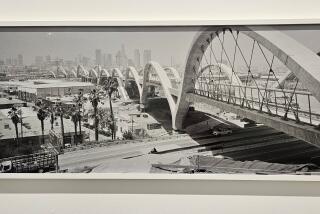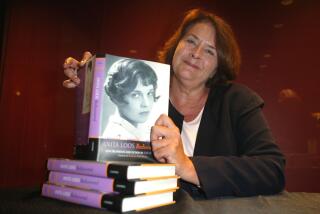The Sunday Conversation: Beth Gates Warren
Beth Gates Warren, a former director of Sotheby’s photographs department, exhumes details about Edward Weston’s lost years in Los Angeles from 1906 to 1923 and his relationship with a highly influential model, muse, photographer and lover in her new book, “Artful Lives: Edward Weston, Margrethe Mather and the Bohemians of Los Angeles” (J. Paul Getty Museum).
Why was so little known about Edward Weston’s early years in Los Angeles?
He basically wanted it that way. He destroyed virtually all of his autobiographical writing prior to 1923 when he departed L.A. for Mexico. And most historians took their cue from him and began writing about his career as though he really began working in Mexico. And that was not the case at all. He actually spent a decade here in Los Angeles building his early career.
What piqued your interest in this?
I had read his daybook, which is what unpublished journals were called, and I learned that they had been heavily edited and that he’d destroyed a portion of them. And I became curious about why he had done that. And I also learned that a woman named Margrethe Mather had been his model in many of his early photographs, and yet he barely mentioned her in his journal. And I just found that strange. There was only one important mention of her in his journal and that was that she was the most important person in his life. And yet he made no effort to explain what he meant by that. And so that statement in combination with the fact that she appeared in so many of his photographs and the fact that he had destroyed so much of his own writing made me curious. I wanted to know why.
Who was Margrethe Mather?
She came to Los Angeles around the same time he did. She later told a friend of hers that she’d been a child prostitute and that she had to leave Salt Lake City because there were people who’d found out about her activities. In later years, she was a prostitute, but I doubt that’s why she left Salt Lake City. A friend of hers tried to find out more about her early life and couldn’t, but that was because Margrethe Mather wasn’t her real name, and I was able to track down several of her distant relatives and they told me her name was actually Emma Caroline Youngren.
When she came to Los Angeles, she became a member of the Los Angeles Camera Club and an amateur photographer. And she had an inherent talent for design and composition, so she very quickly became known because she showed some of her photographs in photographic salons, which were the only way photographers could get their work seen because photography wasn’t exhibited in museums in those days.
And so she met Edward Weston in 1913 through a friend and they very quickly became involved romantically, although Weston was already married and had two children. And she worked with him for an entire decade until he left for Mexico in 1923.
I had the sense from your book that you were at times more impressed with Mather because she was more focused on advancing her artistry and he his career.
Yes, that’s true. She was not a self-promoter. She did not need the kind of attention that Weston seemed to need, and of course he was trying to support a family and needed to build his reputation. She was on her own, but she was also less interested in fame and more interested in the art itself. And I think she was responsible for changing Weston’s attitude, because when she walked into his studio in what is now Glendale — it was an area called Tropico then — he was a very conventional photographer. And once he became more involved with Mather, he began to become an artist.
Did she influence his work more specifically?
I think her eye was in some ways more critical than his. She introduced him to the concept of arranging sitters in less conventional poses, and she encouraged him to utilize composition and line and texture to create a mood — in short, to think like an artist rather than a commercial photographer. And she was an excellent printer herself. And she influenced the way he looked at the world. She brought people from the literary world onto Weston’s horizons, and she was also a friend of Charlie Chaplin’s. She introduced him to dancers and actors.
Can you talk a little more about their circle of artists and bohemians?
There was a fairly large group of creative people who lived in Los Angeles in the teens and ‘20s for a variety of reasons, and one of the key reasons was the movie industry, which attracted writers and designers and photographers. They came to California because they could actually make a living here. So the people who came here were after fame and fortune, and some of them succeeded, like Charlie Chaplin; others were not so lucky, like Florence Deshon, who was a reasonably well-known stage actress and model in New York. Samuel Goldwyn brought her out to become one of the premier actresses at Goldwyn Studio, but she did not persevere and she couldn’t make a living. She was involved with Charlie Chaplin for a while. But as soon as that relationship ended, publicity about her career also ended. And she wound up going back to New York City and committing suicide.
But some of the people who traveled to Los Angeles weren’t involved in the entertainment business. They were coming out here for political reasons. Emma Goldman came out to California on a regular basis. So did Max Eastman, who was the editor of two socialist publications.
Rudolph Valentino lived for a short time right across the street from Margrethe Mather. Boris Karloff lived up the block. There was an amazing array of talent descending on Los Angeles because of all the opportunities here. In a way, the area around Bunker Hill and Silver Lake and Echo Park was the Montparnasse of Los Angeles.
For a year Weston and Mather were equal partners in a photography studio. Why did their relationship end?
Their relationship came to an end because [actress] Tina Modotti walked into his life. Tina was then married — quote unquote, she wasn’t really — to Roubaix [“Robo”] de l’Abrie Richey. In spite of that, Weston never let a marriage license come between him and a romance. So he started a relationship with her. Robo went to Mexico and died there from smallpox. So now all of a sudden Tina wasn’t married or attached to anyone, and Weston thought Mexico was so appealing. Glendale he thought was dull and boring, and Mexico offered lots of artistic opportunity. So he thought that would be a good way to escape from Glendale and family responsibilities, and he and Tina went to Mexico in 1923.
More to Read
The biggest entertainment stories
Get our big stories about Hollywood, film, television, music, arts, culture and more right in your inbox as soon as they publish.
You may occasionally receive promotional content from the Los Angeles Times.






